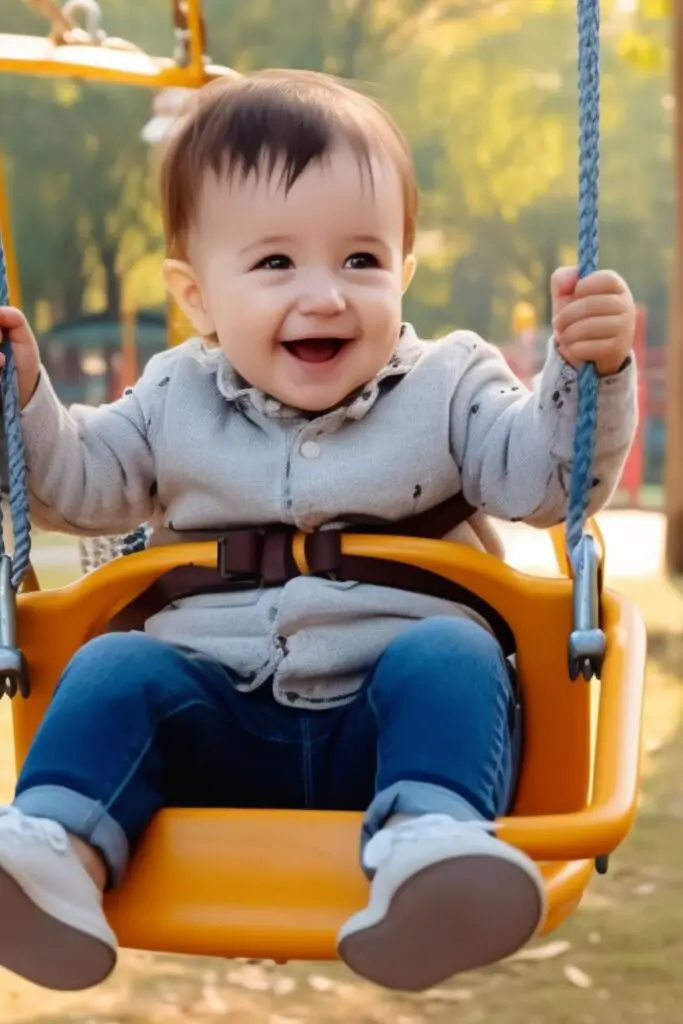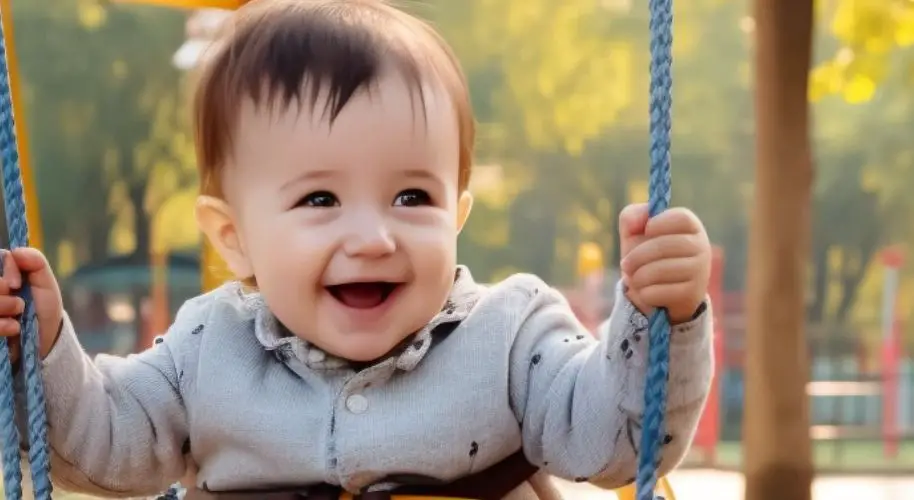Last Updated on June 5, 2025
As parents, we are often excited about introducing our little ones to new experiences, and one of these is the simple joy of a swing at a park. It’s important to know when it’s safe for your baby to start using a swing.
This question is not just about age but also about the developmental milestones your baby has reached. Swinging can be a delightful experience for your child, but safety should always be the foremost concern.
The answer varies depending on your baby’s neck control, sitting abilities, and overall physical development. It’s crucial to ensure that your child is physically ready to handle the motion of a swing before letting them hop on.
Let’s delve deeper into understanding the right age and time for your baby to enjoy a swing at the park.

At what age can my baby start using a park swing?
Babies can start using a park swing at different ages. By age 4 or 5, your child likely be ready to learn how to use swings alone. If the park has baby bucket-style swings, by month 7, your baby is probably old enough to take a gentle spin.
Creative Systems recommends starting with a toddler swing for your baby once they can sit up and have good control of their head, which usually happens between 6-12 months. Our experts suggest that some babies are ready for park swings by 6 months, but most are not ready until at least 8 or 9 months.
Once your baby has good head and neck control and can sit up without support (usually around 9 months old), you can try the infant bucket swing seats. Children as young as six months old can safely enjoy swing sets in seats made for infants.
Should my baby reach a specific weight before using a swing at the park?
Based on the information available, there isn’t a specific weight your baby needs to reach before using a park swing. It’s not so much about weight as physical development and stability.
According to Dr. Jennifer Shu, a pediatrician and author, “A baby can go on a swing at a park once he can sit up well, usually around 9 months.” A Safety Guide states that most swings can accommodate 6 to 30 pounds babies.
Dr. Danelle Fisher, Chair of Pediatrics at Providence Saint John’s Health Center in Santa Monica, California, advises that parents should always look for a swing with safety straps and ensure the baby fits comfortably in the seat without too much room to slide or tip over.
Regarding weight limits for swings, most modern playground swings are designed to carry a maximum load of 250 pounds, with some heavy-duty swings even rated for a minimum of 800 pounds.
Can you provide some tips on playground safety for babies and toddlers?
Here are some essential playground safety tips for babies and toddlers:
Supervision is key:
Always watch your children closely when they’re at the playground. Never leave them unattended.
Check the Equipment:
Before letting your child play, inspect the playground equipment to ensure it’s in good condition and free of potential hazards.
Avoid Strangulation Hazards:
Never allow children to attach ropes, jump ropes, clotheslines, or pet leashes to play equipment.
Dress Appropriately:
Remove necklaces, unzipped jackets, or anything with a drawstring that might get caught on the equipment.
Proper Use of Swings:
Teach your child to sit in the swing, not stand or kneel. They should hold on tightly with both hands while swinging.
Clear Area:
Ensure no rocks, glass, sticks, toys, debris, or other children are at the slide’s base.
Surface Matters:
Avoid playgrounds that have concrete, asphalt, hard-packed soil, or grass. Surfaces made of sand, pea gravel, wood chips, mulch, and shredded rubber are softer and safer for falls.
Avoid Overcrowded Playgrounds:
Overcrowded playgrounds can increase the risk of accidents.
Teach Safe Behavior:
Teach your child not to push, shove, or fight with other children on the playground.
Follow Age-Appropriate Guidelines:
Ensure that your child only uses equipment that is suitable for their age and development level
You Might also Like These Resources!
Why is ensuring safety at the playground crucial?

Ensuring safety at the playground is crucial for several reasons:
Prevention of Injuries:
While designed for fun, playgrounds can pose significant risks if safety measures are not in place. Ensuring safety helps prevent injuries like falls, cuts, and even more severe injuries like fractures or concussions.
Promotes Healthy Play:
When safety measures are in place, children can enjoy their playtime without fear of injury. This encourages physical activity and promotes overall health and well-being.
Teaches Responsibility:
By teaching children about playground safety, we instill in them a sense of responsibility for their safety and the safety of others.
Peace of Mind for Caregivers:
Ensuring playground safety gives parents and caregivers peace of mind knowing their children are playing in a safe environment.
Creates a Safe Community Space:
A safe playground is a valuable community resource where children can play and socialize under safe conditions.
FAQs
Are park swings safe for babies with special needs?
Park swings can indeed be safe for babies with special needs, thanks to the diligent work of organizations and individuals advocating for inclusive playgrounds. Here are some key points:
Inclusive Swings:
Many parks now offer oversized, plastic, brightly colored swings designed specifically for children with disabilities. These swings provide extra support and safety measures to accommodate children with varying physical abilities.
Playground Design:
It’s important to ensure that children of all abilities have access when designing playgrounds. This includes adding equipment specifically designed for wheelchair use or other mobility aids.
ADA Regulations:
Thanks to the Americans With Disabilities Act of 1990, playgrounds are more accessible to children with disabilities. This act stipulates that all playground parts must be accessible to children with disabilities, including those in wheelchairs.
Accommodations:
Common accommodations for children with disabilities might include putting a fence around a playground area, ensuring wheelchair-accessible pathways, and providing adaptive swing seats.
Inclusive Playgrounds:
Inclusive playgrounds aim to meet the needs of all children, particularly those with physical disabilities and cognitive challenges.
What are the basic safety measures when using a baby swing at the park?
Using a baby swing at the park can be a delightful experience for your little one, but it’s important to prioritize their safety. Here are some basic safety measures to consider:
Check Swing Condition:
Before putting your baby in the swing, check its condition. Ensure the seat is clean, the chains or ropes are secure, and no damage could cause harm.
Proper Seating:
Ensure your baby fits securely in the swing seat and is not too small or too big. Some parks have smaller swings designed for infants and toddlers.
Holding On:
Teach your child to hold onto the chains or ropes of the swing. This will help them maintain balance and prevent falls.
Slow and Steady:
Swing your baby gently. A slow, steady motion is safer and usually more enjoyable for little ones.
One at a Time:
Only one child should use a swing at a time. Having multiple children on a swing can lead to collisions and injuries.
Supervision:
Always supervise your child when they’re using the swing. Never leave them unattended.
Safe Distance:
Teach other children to keep a safe distance from swings to avoid accidents.
Getting On and Off:
Assist your child while getting on and off the swing. Sudden jumping or skipping could lead to injuries.
Clothing:
Avoid clothes with drawstrings or cords that can get caught in swing components.
Wrapping up
Playground safety is essential to ensure the health and well-being of your child. By following these guidelines, you can ensure that park swings are a safe and enjoyable experience for your kids.
Parents should also take note of any potential risks at the playground – such as broken glass, sharp objects, or overly crowded areas – and take necessary measures to protect their children. Remember: safety is always the priority!
When it comes to playground safety, there are no shortcuts. It’s important to take the time to teach your children about key safety measures and ensure they understand why these measures are in place.
With a few simple steps, you can ensure your child’s playtime at the park is safe, enjoyable, and rewarding.
You Might Also Like These Latest Content!
- Can You Pack a Baby Swing in Your Luggage?
- Ensuring the Safety of Vibrating Swings for Babies
- Swings Suitable for Baby Sleep: What to Look For

Dr. Leah Alexander is a board-certified general pediatrician who has been in practice for over 20 years. She began working as a pediatrician at Elizabeth Pediatric Group of New Jersey in 2000. Since 2005, she has been working as an independently contracted pediatrician with Medical Doctors Associates at Pediatricare Associates of New Jersey. Read more
